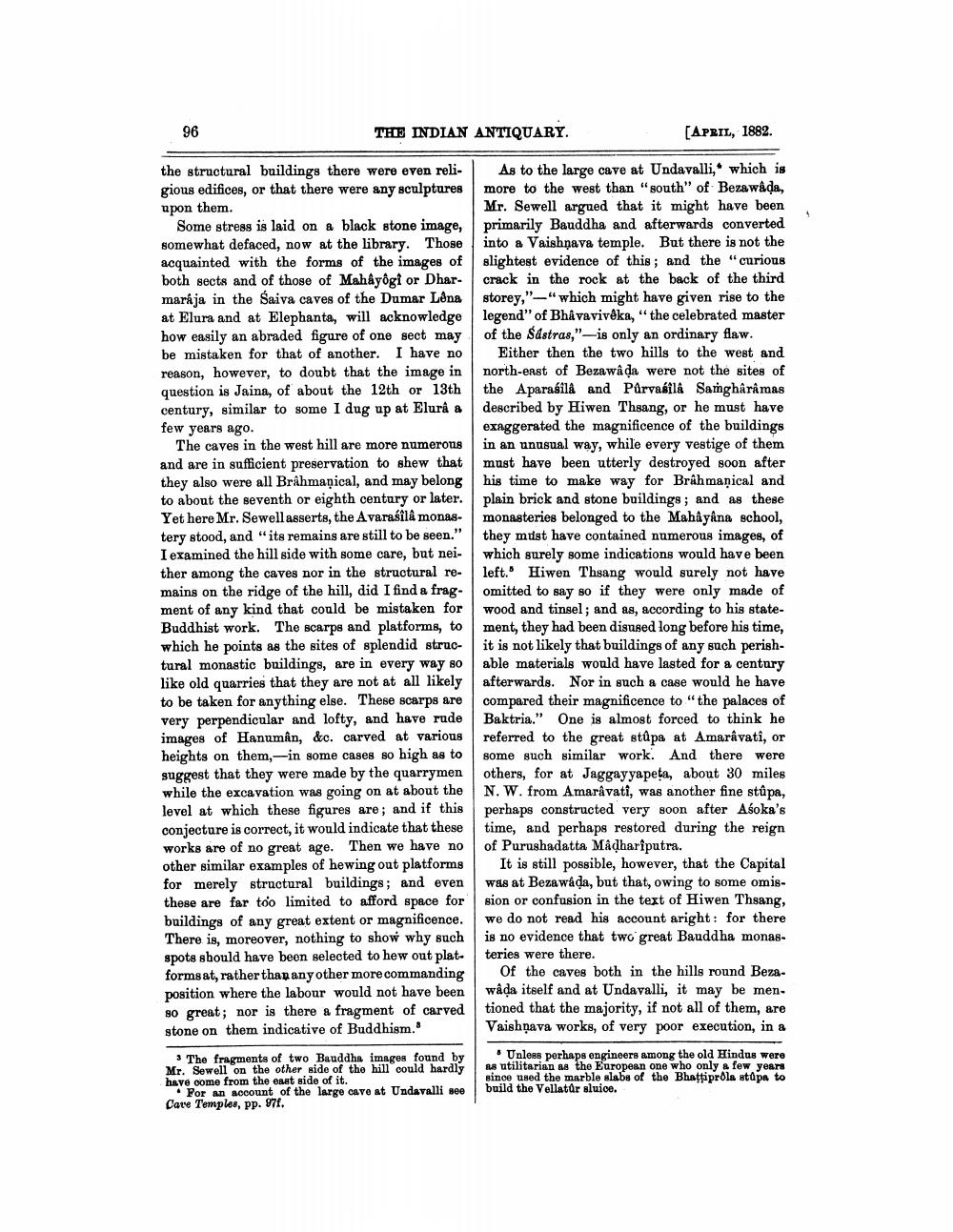________________
96
THE INDIAN ANTIQUARY.
[APRIL, 1882.
the structural buildings there were even reli- gious edifices, or that there were any sculptures upon them.
Some stress is laid on a black stone image, somewhat defaced, now at the library. Those acquainted with the forms of the images of both sects and of those of Mahayogi or Dharmarája in the Saiva caves of the Dumar Lồna at Elura and at Elephanta, will acknowledge how easily an abraded figure of one sect may be mistaken for that of another. I have no reason, however, to doubt that the image in question is Jaina, of about the 12th or 13th century, similar to some I dug up at Elurâ a few years ago.
The caves in the west hill are more numerous and are in sufficient preservation to shew that they also were all Brahmaņical, and may belong to about the seventh or eighth century or later. Yet here Mr. Sewell asserts, the Avarasilâ monastery stood, and "its remains are still to be seen." I examined the hill side with some care, but nei. ther among the caves nor in the structural remains on the ridge of the hill, did I find a frag. ment of any kind that could be mistaken for Buddhist work. The scarpe and platforms, to which he points as the sites of splendid structural monastic buildings, are in every way so like old quarries that they are not at all likely to be taken for anything else. These scarps are very perpendicular and lofty, and have rude images of Hanuman, &c. carved at various heights on them,-in some cases so high as to suggest that they were made by the quarrymen while the excavation was going on at about the level at which these figures are; and if this conjecture is correct, it would indicate that these works are of no great age. Then we have no other similar examples of hewing out platforms for merely structural buildings; and even these are far too limited to afford space for buildings of any great extent or magnificence. There is, moreover, nothing to show why such spots abould have beon selected to hew out plat. forms at, rather than any other more commanding position where the labour would not have been 90 great; nor is there a fragment of carved stone on them indicative of Buddhism.
As to the large cave at Undavalli," which is more to the west than “south" of Bezawada, Mr. Sewell argued that it might have been primarily Bauddha and afterwards converted into a Vaishnava temple. But there is not the slightest evidence of this; and the "curious crack in the rock at the back of the third storey, "-"which might have given rise to the legend" of Bhåvaviveka," the celebrated master of the Sastras,"-is only an ordinary flaw.
Either then the two hills to the west and north-east of Bezawada were not the sites of the Aparašila and Parvabila Samgharâmas described by Hiwen Thsang, or he must have exaggerated the magnificence of the buildings in an unusual way, while every vestige of them must have been utterly destroyed soon after his time to make way for Brahmanical and plain brick and stone buildings; and as these monasteries belonged to the Mahâyâna school, they must have contained numerous images, of which surely some indications would have been left. Hiwen Thsang would surely not have omitted to say so if they were only made of wood and tinsel; and as, according to his statement, they had been disused long before his time, it is not likely that buildings of any such perishable materials would have lasted for a century afterwards. Nor in such a case would he have compared their magnificence to "the palaces of Baktria." One is almost forced to think he referred to the great stupa at Amaravati, or some such similar work. And there were others, for at Jaggayyapeta, about 30 miles N. W. from Amaravati, was another fine stậpa, perhaps constructed very soon after Aśoka's time, and perhaps restored during the reign of Purushadatta Madhariputra.
It is still possible, however, that the Capital Wals at Bezawada, but that, owing to some omission or confusion in the text of Hiwen Thsang, we do not read his account aright: for there is no evidence that two great Bauddha monasteries were there.
Of the caves both in the hills round Bezawada itself and at Undavalli, it may be mentioned that the majority, if not all of them, are Vaishnava works, of very poor execution, in a
3 The fragments of two Bauddha images found by Mr. Sewell on the other side of the hill could hardly have come from the east side of it.
• For an account of the large cave at Undavalli see Cave Temples, pp. 978.
Unless perhaps engineers among the old Hindus were as utilitarian as the European one who only a few years since used the marble slaba of the Bhattiprola stúpa to build the Vellatúr sluice.




